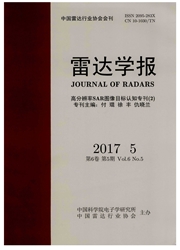

 中文摘要:
中文摘要:
在建筑密集的城区复杂场景中,高分辨率SAR影像中存在严重的叠掩效应,影像解译的难度加大。SAR层析成像可以分离单个分辨单元内混叠的散射体目标,并且获取各个散射体的3维位置和后向散射强度。该文首先论述了3维SAR层析成像的基本原理,针对传统谱估计法获得的高程向分辨率较低的问题,综述了压缩感知方法在城区3维SAR层析成像中的应用,以基追踪和双步迭代收缩阈值法为例,开展了TerraSAR-X聚束模式数据实验,并与传统的奇异值阈值法进行了对比分析。研究结果表明压缩感知方法的高程向超分辨率、旁瓣抑制优势明显,在城区SAR层析成像中具有广阔的应用前景。
 英文摘要:
英文摘要:
In modern high resolution SAR data, due to the intrinsic side-looking geometry of SAR sensors, layover and foreshortening issues inevitably arise, especially in dense urban areas. SAR tomography provides a new way of overcoming these problems by exploiting the back-scattering property for each pixel. However, traditional non-parametric spectral estimators, e.g. Truncated Singular Value Decomposition (TSVD), are limited by their poor elevation resolution, which is not comparable to the azimuth and slant-range resolution. In this paper, the Compressive Sensing (CS) approach using Basis Pursuit (BP) and TWo-step Iterative Shrinkage/Thresholding (TWIST) are introduced. Experimental studies with real spotlight-mode TerraSAR-X dataset are carried out using both BP and TWIST, to demonstrate the merits of compressive sensing approaches in terms of robustness, computational efficiency, and super-resolution capability.
 同期刊论文项目
同期刊论文项目
 同项目期刊论文
同项目期刊论文
 期刊信息
期刊信息
